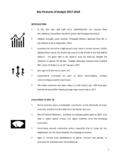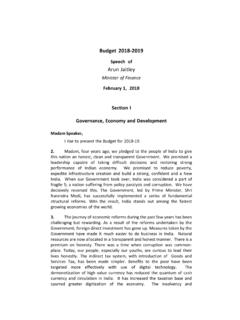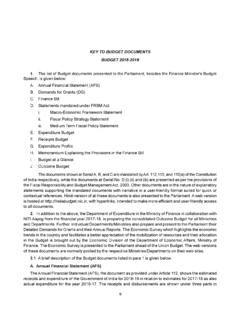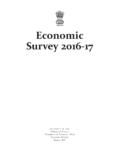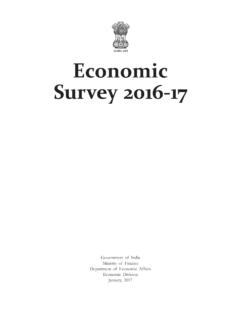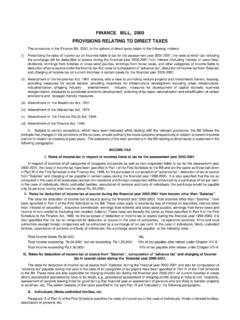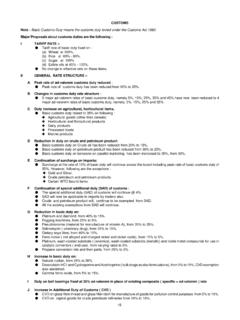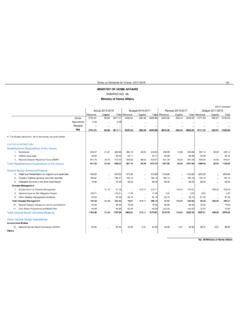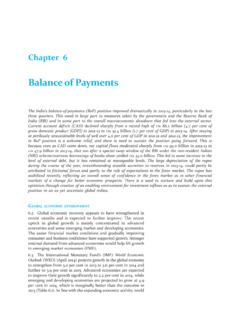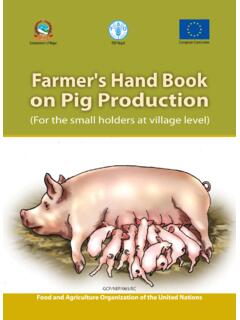Transcription of 07 - Union Budget
1 CHAPTER07(Who have the shade of cornful crest Under their umbra umbrella rest.) ThiruvalluvarThe resilience of India s agriculture sector can be seen from the fact that despite the COVID-19 pandemic, its performance in output was strong. About per cent of the total workforce in the country is still engaged in agricultural and allied sector activities (Census 2011) which accounts for approximately per cent of the country s Gross Value Added (GVA) for the year 2019-20 (at current prices). While the difficulties created by COVID induced lockdowns adversely affected the performance of the non-agricultural sectors, the agriculture sector came up with a robust growth rate of per cent at constant prices during 2020-21 (first advance estimates). The sector has got renewed thrust due to various measures on credit, market reforms and food processing under the Atma Nirbhar Bharat announcements. Various interventions of the Government for the development of allied sectors including animal husbandry, dairying and fisheries exhibit its resolve towards tapping the potential of allied sectors to further enhance farm welfare.
2 In addition to various measures aimed at increasing productivity and improving marketing of agricultural produce, the Government also carries out a large food management programme with a significant financial implication in terms of food subsidy. Under the Pradhan Mantri Garib Kalyan Anna Yojana, crores beneficiaries were provided additional foodgrains, above the NFSA mandated requirements, of 5 kg per person per month free of cost till November, 2020. Over 200 LMT of foodgrains were provided amounting to a fiscal outgo of over ` 75000 Crores. Also, under Atma Nirbhar Bharat Package, 5 kg per person per month was distributed for four months (May to August) to benefit approximately 8 crores migrants who are not covered under NFSA or state ration card entailing subsidy of ` 3109 crores & Food COVID-19 pandemic has influenced the lives of people across the globe and India is no exception to that. The farming activities also experienced the impact of this pandemic as the COVID induced lockdowns influenced the movement of farm inputs including farm machinery from one location to other.
3 The national lockdown coincided with the commencement of the harvesting season for the Rabi crops creating further adversity for the sector. Migration of agricultural labourers to their native places during the lockdown created a shortage of farm 231 Agriculture & Food Managementlabourers. India s agricultural system demonstrated its resilience amid such adversities. The agriculture and allied sectors were the sole bright spot amid the slide in performance of other sectors, clocking a growth rate of per cent at constant prices during 2020-21. Against all adversities due to COVID-19, continuous supply of agriculture commodities, especially staples like rice, wheat, pulses and vegetables, has been maintained thereby enabling food security. In order to further strengthen and support the agricultural sector, several initiatives have been taken by the Government of India under the Atma Nirbhar Bharat Abhiyan (Box 1).
4 Box 1: Major Announcements for Agriculture and Food Management under the Atma Nirbhar Bharat AbhiyanAnnouncementObjectives` 1 lakh crores Agri Infrastructure FundFinancing will be provided for funding agriculture infrastructure projects at farm-gate & at aggregation points and for financially viable post-harvest management infrastructure. ` 10,000 crores scheme for Formalisation of Micro Food Enterprises (MFE)Aiding 2 lakh MFEs who need technical upgradation to attain FSSAI food standards, build brands and support marketing.` 20,000 crores for fisherman through Pradhan Mantri Matsya Sampada Yojana (PMMSY)It aims at integrated, sustainable and inclusive development of marine and inland fisheries by developing infrastructure such as fishing harbours, cold chain, markets, Animal disease Control ProgrammeIt targets foot and mouth disease (FMD) and Brucellosis by ensuring 100 per cent vaccination of cattle, buffalo, sheep, goat and pig Husbandry Infrastructure Development Fund - ` 15,000 croresIt is to support private investment in dairy processing, enable value addition and improved cattle feed infrastructure.
5 From TOP to TOTAL Operation Greens run by Ministry of Food Processing Industries (MOFPI) to be extended from tomatoes, onion and potatoes to ALL fruit and in Essential Commodities Act, Agriculture Marketing and Agriculture Produce Pricing and Quality AssuranceThese legislative reforms seek to remove agricultural commodities such as cereals, pulses, oilseeds etc. from the list of essential commodities and aim to reform agricultural Garib Kalyan Ann YojanaThe scheme aimed at ensuring food and nutritional security to around 80 crores ration card holders who were affected due to the COVID-19 induced national Nation One Ration Card SchemeThis scheme will enable migrant workers and their family members to access PDS benefits from any fair price shop in the Survey 2020-21 Volume 2 OVERVIEW OF AGRICULTUREG ross Value Added in As per the provisional estimates of national income released by CSO on 29th May, 2020, the share of agriculture and allied sectors in Gross Value Added (GVA) of the country at current prices is per cent for the year 2019-20.
6 GVA of agriculture and allied sectors and its share in total GVA of the country during the last six years at current prices is as given in Table 1. Table 1: Share of Agriculture and Allied Sectors in Total GVA at current pricesItemsYear2014-152015-162016-17*201 7-18#2018-19@2019-20**Share of GVA of Agriculture & Allied Sector in GVA of Total Economy (per cent) of of of Forestry & logging of Fishing & : Department of Agriculture, Cooperation & Farmers Welfare (DAC&FW).Note:**As per the Provisional Estimates of Annual National Income 2019-20 released by CSO on 29th May 2020. @As per the First Revised Estimates of National Income, Consumption Expenditure, Saving and capital Formation for 2018-19 released on 31st January, 2020. # Second Revised Estimate. * Third Revised Data not The share of agriculture and allied sectors in GVA of the country has declined from per cent in 2014-15 to per cent in 2019-20 (Table 1), an inevitable outcome of a development process in which the relative performance of non-agricultural sectors becomes more dominant.
7 Within the agriculture sector, the share of crops has fallen from per cent in 2014-15 to per cent in 2018-19. The decline in the share of crops has been made up by an increase in the share of livestock and fisheries 1: Share of Agriculture and Allied Sectors in Total GVA of the Country at Current Prices (in per cent)* of CropsShare of LivestockShare of Forestry & loggingShare of Fishing &aquaculture2014-152015-162016-17*2017-1 8#2018-19@2019-20 **Source: Created from the data in Table 1.*All the symbols attached with the years in the graph denote the same as indicated in Table & Food ManagementGrowth in Agriculture & Allied The growth in GVA of agriculture and allied sectors has been fluctuating over time (Figure 2). However, during 2020-21, while the GVA for the entire economy contracted by per cent, growth in GVA for agriculture maintained a positive growth of per cent.
8 Figure 2: Growth of GVA of Economy and Agriculture & Allied Sectors at Constant (2011-12) Prices (In per cent) *2017-18#2018-19@2019-20**2020-21**Growt h of GVA of Total EconomyGrowth of GVA of Agriculture & Allied Sector (per cent)Source: Based on data received from DAC& : **As per the Provisional Estimates of Annual National Income 2019-20 released by CSO on 29th May 2020. @As per the First Revised Estimates of National Income, Consumption Expenditure, Saving and capital Formation for 2018-19 released on 31st January, 2020. # Second Revised Estimate. * Third Revised Estimate. ** First Advance Estimates of National Income released on 7th January, Capital Gross Capital Formation (GCF) in the agriculture and allied sector as a proportion to GVA has been showing a fluctuating trend from per cent in 2013-14 to per cent in 2018-19, with a dip to per cent in 2015-16.
9 The share of GCF of the agriculture & allied sector to GVA of agriculture & allied sector for the years 2013-14 to 2018-19 at 2011-12 basic prices is shown in Figure 3: GCF of Agriculture & Allied Sector as percentage of GVA of Agriculture & Allied Sector (at 2011-12 basic prices) *2017-18#2018-19@Source: Based on data received from DAC&FW.@As per the First Revised Estimates of National Income, Consumption Expenditure, Saving and capital Formation for 2018-19 released on 31st January, 2020. # Second Revised Estimate. * Third Revised Survey 2020-21 Volume 2 Production of In the year 2019-20 (as per fourth advance estimates), total food grain production in the country is estimated at record million tonnes which is higher by million tonnes than the production of food grain of million tonnes achieved during 2018-19. Further, the production during 2019-20 is higher by million tonnes than the previous five years (2014-15 to 2018-19) average production of million tonnes.
10 A diagrammatic trend in output of major crops for the last five years are shown in Figure 4 and Figure 4: Trend in Production of Rice and Wheat Crops (Quantity in Million Tonnes) 0204060801001202015-162016-172017-182018 -192019-20*RiceWheatSource: Created from the data of the 1st Adv. Estimate released dated *4th Advanced 5: Trend in Production of Other Major Crops (Quantity in Million Tonnes) 051015202530354045502015-162016-172017-1 82018-192019-20*Nutri/Coarse CerealsPulsesOilseedsCotton@Source: Created from the data of the 1st Adv. Estimate released dated *4th Advanced Estimates. @ Production of cotton is in million & Food ManagementAgricultural Given the large proportion of resource constrained small and marginal farmers in India, timely availability of adequate credit is fundamental for the success of farming activities. The agricultural credit flow target for the year 2019-20 was fixed at ` 13,50,000 crores and against this target the achievement was ` 13,92, crores.
